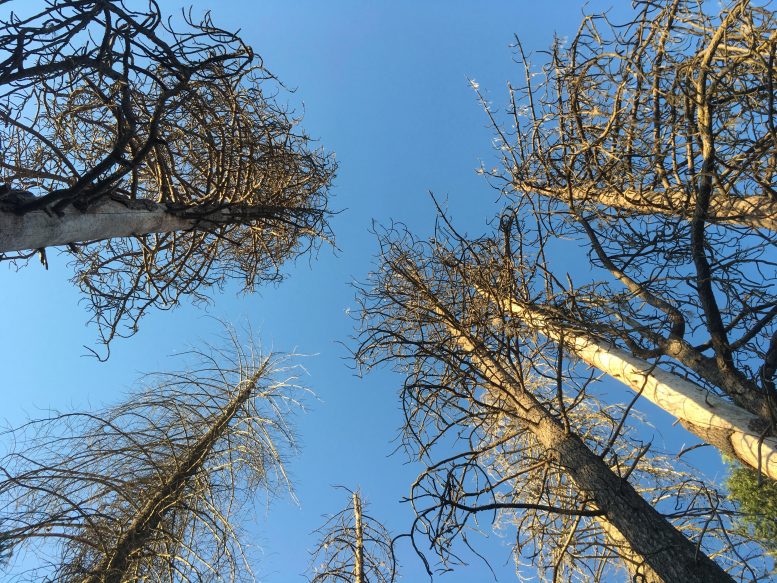
Due to lower tree-stand density, it is unlikely that massive infestations fueled by climate change will reoccur.
The Sierra Nevada’s Ponderosa pine forests, which were devastated by western pine beetles during the 2012-2015 megadrought, will not regain their pre-drought density, leading to a reduction in an important storehouse for atmospheric carbon.
“Forests store huge amounts of atmospheric carbon, so when western pine beetle infestations kill off millions of trees, that carbon dioxide goes back into the atmosphere,“ said Zachary Robbins, a postdoctoral at Los Alamos National Laboratory.
Robbins is the corresponding author of a new paper published in the journal Frontiers in Environmental Science about carbon stored in living ponderosa pines in the Sierra Nevada of California.
“We also found that because so many trees died during the megadrought, there’s much less risk of another huge die-off this century because the bark beetles will have fewer host trees,” he said.
A mixed bag of impacts
It’s a mixed bag, however. Western pine beetle outbreaks driven by climate change will continue to occur, limiting forest regeneration after the drought.
“Some carbon loss won’t be resequestered in trees, but fewer trees on the landscape dampen the severity of western pine beetle outbreaks,” Robbins said. “The forest seems to reach an equilibrium at a certain point.”
The beetle needs a minimum density of trees to support explosive population growth. “Our paper found that as forests reach a certain threshold of ponderosa pine density, they become exponentially more likely to have western pine beetle-driven die-off,” Robbins said.
Complex interactions among climate change, weather, trees, and beetles are decimating ponderosa forests in California and elsewhere. During the 2012-2015 drought, an estimated 129 million trees of various species died in the Sierra Nevada.
Carbon sink or carbon source?
As carbon sinks, forests sequester, or store, more than a tenth of the greenhouse-gas emissions in the United States. Trees can use the increasing carbon in the air to grow and thus fix more carbon in the form of wood.
“If there’s no disturbance, such as a beetle outbreak, then the carbon gets stored, but when the beetle comes with the higher temperatures of climate change, their populations develop more rapidly,” said Chonggang Xu, a senior scientist at Los Alamos and a co-author of the paper. “Fewer beetles die in the winter because of warmer minimum temperatures.”
Add in climate-driven drought, and “it all contributes to more frequent beetle outbreaks,” Xu said.
“The ecosystem has been fundamentally changed by the effects of climate change,” Xu said. “That means the forest can’t recover to the pre-megadrought carbon level.”
During an outbreak, millions of trees die and begin releasing carbon back into the atmosphere through microbial decay.
Carbon-budget buster
Xu said it’s critical for future carbon budgeting to include the effects on forest regeneration caused by beetle outbreaks and other disturbances such as drought and fire. Carbon budgeting involves understanding how to manage carbon emissions to prevent catastrophic warming.
Rising temperatures also compound the effects of drought. “In the past, a three-year drought would have a substantial impact on tree mortality,” Xu said. “But in a warmer future, a two-year drought could have similar consequences.”
Robbins, Xu, and their collaborators simulated forests and beetle dynamics at 31 sites where ponderosa pines predominate in the central and southern Sierra Nevada. To study tree growth, regeneration, and background mortality, they modeled insect mortality and phenology (cyclical biological events), tree defense, and insect attacks.
They considered two periods, 2006-2018 and 2018-2100. The team used data from observations and modeling to simulate the climate for each site for 2006-2018 and they used climate model data alone for the 2018-2100 projections.
Outbreaks in California and beyond
The work has implications for ponderosa forests beyond California.
“Many of the interactions we describe here are very similar to those across the West, where you have warming temperatures helping beetle populations and you have dense forests of stressed trees, which will continue to be stressed by future drought,” Robbins said. “That will increase the risk of outbreaks. Our paper is specific to California, but it’s a fundamental problem and we expect it to be reflected in many different forests throughout the western United States.”
Xu and Robbins said their results reflect what land managers have known for many years: Overstocked pine stands are particularly susceptible to beetle outbreaks. As droughts increase in severity, managers may have to scale back forest density through active management to mitigate the increased risk.
“Our evidence shows there’s a lot to be gained by those proactive management processes,” Robbins said.
In a related 2022 paper, Robbins, Xu, and collaborators published a new modeling framework to assess the risk bark beetles pose in many forest ecosystems under climate change. Adding together the effects of compromised tree defenses (15% to 20%) and increased bark beetle populations (20%), the team determined that 35% to 40% more ponderosa pines would die from beetle attacks for each degree Celsius of warming.
Reference: “Carbon stored in live ponderosa pines in the Sierra Nevada will not return to pre-drought (2012) levels during the 21st century due to bark beetle outbreaks” by Zachary J. Robbins, Chonggang Xu, Alex Jonko, Rutuja Chitra-Tarak, Christopher J. Fettig, Jennifer Costanza, Leif A. Mortenson, Brian H. Aukema, Lara M. Kueppers and Robert M. Scheller, 14 March 2023, Frontiers in Environmental Science.
DOI: 10.3389/fenvs.2023.1112756
The study was funded by the Los Alamos National Laboratory LDRD and the University of California National Laboratory Fees Research Program.